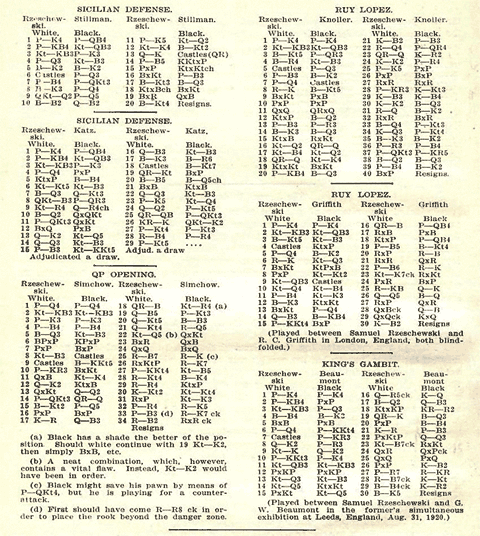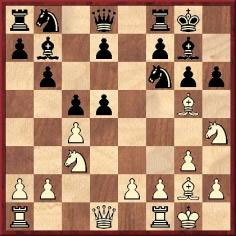


Winning starts with what you know
The new version 18 offers completely new possibilities for chess training and analysis: playing style analysis, search for strategic themes, access to 6 billion Lichess games, player preparation by matching Lichess games, download Chess.com games with built-in API, built-in cloud engine and much more.

P. Van Elsuwe: ‘Une simultanée mouvementée’ (from page 323
of Les Cahiers de l’Echiquier Français,
July-August 1934)
Readers who have participated in simultaneous displays – either as the single player or as the ‘simultanee’ (a neologism used as long ago as 1943) – are invited to contribute to the ChessBase Simul Hunt. Particularly interesting games will be discussed/annotated by a master, and all relevant game-scores will go into a database.
The aim of the project is to save from oblivion as many as possible of the innumerable games played in simultaneous exhibitions but hitherto unpublished. It is rare nowadays for such encounters to be seen in chess magazines, contrary to the widespread practice in previous times. To give an example at random, the following appeared on page 188 of the December 1920 American Chess Bulletin:

There is no cause for high-mindedness about games played in ‘mere’ simultaneous displays. A number of the greatest players – Alekhine is a prominent example – have included such contests in their Best Games collections, and the only leading master who comes immediately to mind for speaking out strongly against this form of chess is Howard Staunton. ‘That silliest of all chess exploits’, he wrote in the Illustrated London News of 14 April 1866. (See pages 238-239 of our book Chess Explorations.)

Garry Kasparov
To launch the Hunt, we present three games involving Kasparov which feature in our books, having kindly been submitted by his opponents:
Garry Kasparov – Tim Krabbé1 d4 d5 2 c4 c6 3 Nf3 Nf6 4 Nc3 e6 5 Qb3 Nbd7 6 Bg5 Be7 7 e3 O-O 8 Bd3 dxc4 9 Bxc4 b5 10 Be2 a6 11 O-O c5 12 Rfd1 Qc7 13 Bf4 Qb6 14 a4 b4 15 a5 Qa7 16 Na4 Nd5 17 Bg3 cxd4 18 Nxd4 Nc5 19 Nxc5 Bxc5

20 Nc6 Qb7 21 Ne5 Qe7 22 Nd3 f5 23 Nxc5 Qxc5 24 Rac1 Qxa5 25 Rc6 Re8 26 Bh5 g6 27 Bf3 Qb5 28 Rxd5 exd5 29 Bxd5+ Kh8 30 Rc7 Qe2 31 h3 Rb8 32 Bc4 Qe1+ 33 Kh2 f4

34 Bxf4 Qxf2 35 Qd3 Qxb2 36 Qd5 Qf6 37 Bg5 Qb2

38 Rxh7+ Resigns. [Click to replay]
When contributing this game (in C.N. 1458) Tim Krabbé commented to us: ‘He absolutely thrashed me, and I’m rated at 2300!’ A decade later, two faster wins for White (35 Bg8 and 38 Qf7) were pointed out by Michael Lorenz at the Chess Café, and Douglas Bryson noted, courtesy of Fritz, that 34 Bh4 mates in six. See pages 288-289 of Kings, Commoners and Knaves.
Garry Kasparov – Harald E. Balló1 d4 Nf6 2 c4 e6 3 g3 c5 4 Nf3 b6 5 Bg2 Bb7 6 d5 exd5 7 Nh4 g6 8 Nc3 Bg7 9 O-O O-O 10 Bg5 h6

11 Bxf6 Bxf6 12 Nxg6 Bxc3 13 bxc3 Re8 14 Nf4 Nc6 15 Bxd5 Qg5 16 e4 Rad8 17 Nd3 Na5 18 f4 Qg7 19 e5 Ba6 20 Qa4 d6 21 Rae1 dxe5 22 Nxe5 Re7

23 Nxf7 Rxf7 24 Re8+ Rxe8 25 Qxe8+ Qf8 26 Bxf7+ Kg7 27 Qxf8+ Kxf8 28 Bd5 Nxc4 29 Re1 Na3 30 Re6 Bd3 31 Rxh6 Nb5 32 c4 Nc3 33 Kf2 Kg7 34 Rc6 Nxa2 35 Rc7+ Kf6 36 g4 Kg6 37 h4 Nb4 38 h5+ Kh6 39 Kg3 Nxd5 40 cxd5 Black resigns. [Click to replay]
A brief discussion of the position after 10...h6, which had arisen in Capablanca v Marshall, Carlsbad, 1929, is to be found, with this game, on pages 60-61 of Kings, Commoners and Knaves.
Garry Kasparov – Claus van de Vlierd1 e4 c6 2 d4 d5 3 Nd2 dxe4 4 Nxe4 Bf5 5 Ng3 Bg6 6 Bc4 e6 7 N1e2 Nf6 8 O-O Bd6 9 f4 O-O 10 f5 exf5 11 Nxf5 Bxf5 12 Rxf5 Nbd7 13 Qd3 Qc7 14 Ng3 Bxg3 15 hxg3 Nb6 16 Bb3 Nbd5 17 Bg5 Rae8 18 c4 Ne7 19 Rf3 Ng4 20 Raf1 Qd7 21 Bd2 Rd8 22 Bb4 Nf6 23 d5 cxd5 24 cxd5 Rfe8

25 Rxf6 gxf6 26 Rxf6 Nxd5 27 Rh6 Nf6

28 Rg6+ Kh8 29 Bc3 hxg6 30 Bxf6+ Kh7 31 Qc4 Qf5 32 Bxd8 (There was a mate in four with 32 Qxf7+.) 32…Re1+ 33 Kh2 Qh5+ 34 Qh4 Resigns. [Click to replay]
Submit games
that you have played in simultaneous displays
Please give the full names of both White and Black, the exact date and venue,
and the result.
Games can be submitted in PGN (preferred) or as text in algebraic notation.
 Edward
Winter is the editor of Chess
Notes, which was founded in January 1982 as "a forum for aficionados
to discuss all matters relating to the Royal Pastime". Since then over
5,600 items have been published, and the series has resulted in four books by
Winter: Chess
Explorations (1996), Kings,
Commoners and Knaves (1999), A
Chess Omnibus (2003) and Chess
Facts and Fables (2006). He is also the author of a monograph
on Capablanca (1989).
Edward
Winter is the editor of Chess
Notes, which was founded in January 1982 as "a forum for aficionados
to discuss all matters relating to the Royal Pastime". Since then over
5,600 items have been published, and the series has resulted in four books by
Winter: Chess
Explorations (1996), Kings,
Commoners and Knaves (1999), A
Chess Omnibus (2003) and Chess
Facts and Fables (2006). He is also the author of a monograph
on Capablanca (1989).
Chess Notes is well known for its historical research, and anyone browsing in its archives will find a wealth of unknown games, accounts of historical mysteries, quotes and quips, and other material of every kind imaginable. Correspondents from around the world contribute items, and they include not only "ordinary readers" but also some eminent historians – and, indeed, some eminent masters. Chess Notes is located at the Chess History Center. Signed copies of Edward Winter's publications are currently available.